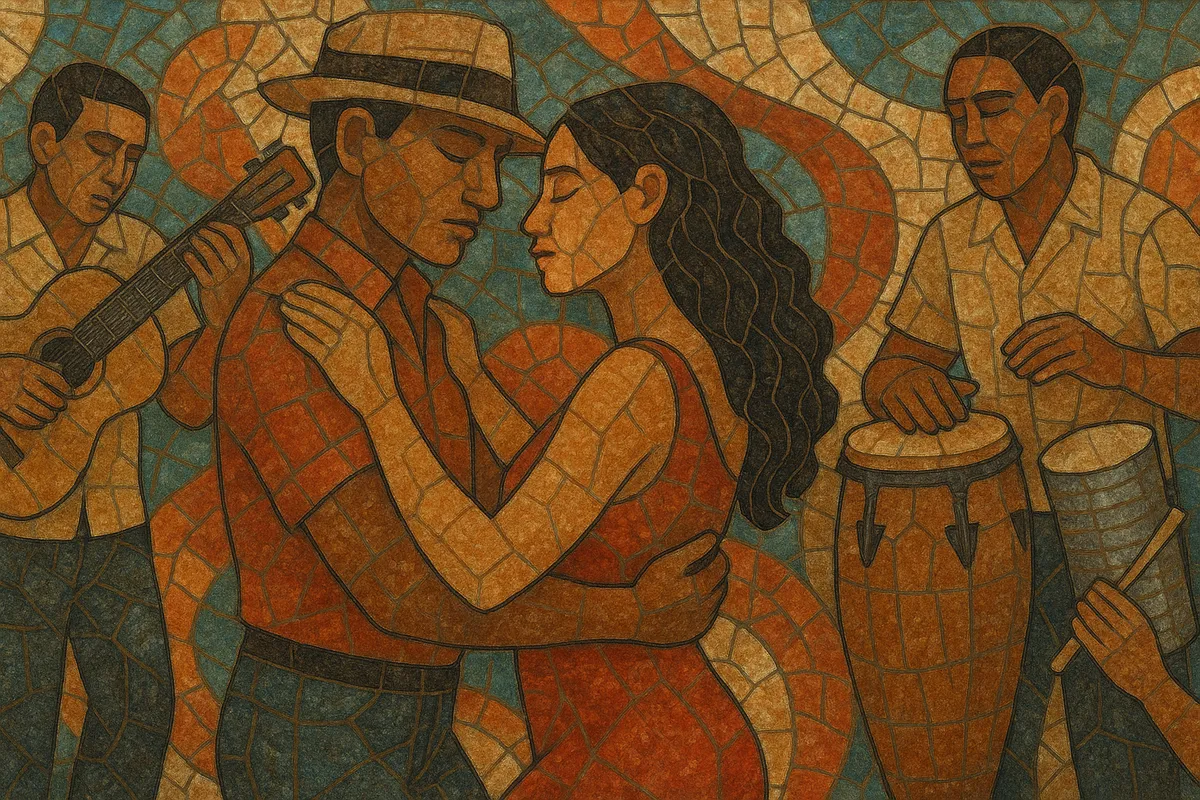Bachata is a guitar-driven popular music and dance style that originated in the Dominican Republic. It blends the romantic lyricism and harmonic language of bolero with rhythmic accents and dance energy connected to Dominican merengue and Afro-Caribbean son traditions.
The classic ensemble features a lead guitar (requinto), rhythm guitar, bass, bongos, and güira. Typical songs are in 4/4 time with syncopated bongo martillos and a steady güira pattern, while the guitars alternate arpeggios, bachata rasgueos, and melodic fills. Lyrically, bachata is renowned for amargue (bitterness)—poignant narratives of love, longing, heartbreak, and desire—though modern variants also embrace flirtation and celebration.
Since the 1990s, "bachata romántica" and 2000s urban/pop bachata have expanded the sound with electric guitars, keyboards, R&B harmonies, and pop structures, taking the genre from a once-marginalized style to a global Latin pop mainstay.
Bachata emerged in the Dominican Republic in the early 1960s, growing out of bolero guitar traditions performed in bars and patios, and absorbing rhythms and phrasing from Cuban son and Dominican merengue. In 1962, José Manuel Calderón recorded foundational bachatas such as "Borracho de amor" and "Condena," widely cited as the genre’s first commercial recordings. Early bachata—then often called bolero campesino or simply amargue—was characterized by intimate guitar ensembles and intensely romantic, sometimes raw, storytelling.
For decades, bachata was stigmatized by urban elites as rural and low-class, limiting radio play and mainstream acceptance. Nevertheless, it thrived via jukeboxes, local stations, and live performance. In the mid-1980s, Blas Durán helped modernize the sound by introducing electric guitar riffs, more pronounced rhythmic drive, and humorous, double-entendre lyrics, paving the way for a less stigmatized, dance-forward style.
The 1990 release of Juan Luis Guerra’s album "Bachata Rosa" reframed public perception, proving bachata could be sophisticated, poetic, and commercially successful. Artists like Antony Santos, Raulin Rodríguez, Frank Reyes, and Zacarias Ferreira then defined the bachata romántica movement, emphasizing polished vocals, lush harmonies, and refined guitar work that resonated widely across the Dominican diaspora and Latin America.
In the 2000s, Aventura (with lead singer Romeo Santos) fused bachata with R&B, hip hop, and pop aesthetics, scoring international hits such as "Obsesión" and opening global markets. The 2010s saw further crossover via Romeo Santos’s solo career and Prince Royce’s bilingual pop-bachata hits. Today, bachata thrives as both a traditional dance music and a flexible pop platform, influencing reggaeton fusions (bachatón) and mainstream Latin pop while sustaining deep roots in guitar-based romantic songwriting.
Use a classic quintet: lead guitar (requinto), rhythm guitar, electric bass, bongos, and güira. Keep a 4/4 meter at a danceable tempo—often in the 120–132 BPM range. The bongos play a steady martillo pattern with expressive fills (cierre) at phrase ends, while the güira provides a continuous, bright, syncopated scrape that locks the groove.
Let the rhythm guitar lay out a steady rasgueo/ostinato, often outlining I–IV–V progressions in major keys or i–VII–VI–VII in minor. The lead guitar plays melodic hooks, ornamental slides, grace notes, and short call-and-response fills between vocal lines. Introduce turnarounds and passing chords borrowed from bolero (e.g., ii–V–I cadences) to add elegance. Modern pop-bachata frequently uses I–V–vi–IV and related pop sequences for instantly catchy choruses.
Compose singable, emotive melodies with clear phrasing and space for guitar interjections. Write lyrics centered on love, longing, betrayal, and reconciliation—the emotional spectrum known as amargue. Structure songs with a short instrumental intro hook (lead guitar), verse–pre-chorus–chorus, a brief guitar solo or breakdown, and a final chorus with added ad-libs.
Keep the low end tight but supportive; a simple tumbao-like bass line that emphasizes chord roots and anticipations works well. Add congas, keys, or string pads for modern polish, but let guitars remain the focal point. Use subtle reverb and chorus on the lead guitar for sheen, and highlight percussive articulation so dancers can feel the groove.
Maintain a consistent, forward-driving pulse that supports the signature side–together–side bachata step with turns. Accentuate syncopations before beat three and use tasteful bongo/guitar fills to mark transitions without disturbing the dance flow.


